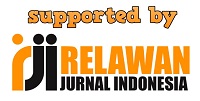PENGENDALIAN PENYAKIT ANTRAKNOSA (Colletotrichum capsici) PADA CABAI MERAH DENGAN BEBERAPA BAKTERI SEBAGAI AGEN BIOKONTROL
Abstract
Research has been conducted to determine some of the bacteria of antraknosa disease control in chilies (Capsicum annum L.) with in vitro and in vivo methods conducted in the Agroecology Laboratory, Agriculture Faculty of Sultan Ageng Tirtayasa University on June to October 2011. The research uses Completely Randomized Design same factors as rizo-bacterium bio-control agents. In in vitro test for each factor composed of three level they are application of bio-control from the Pseudomonas fluorescens rizo-bacterium, application of bio-control from the Bacillus sp. rizo- bacterium, and without using a biocontrol agents. In in vivo tests of each factor is composed of 5 levels they are (CO+) without bio-control agents on uninfected chilies, (CO-) without biocontrol agents on infected chilies, with bio-control agents from the Bacillus sp. rizo-bacterium on infected chilies, with bio-control agents from the Bacillus sp. rizo-bacterium on infected chilies, and use bio-control agents combinations of P.fluorescens and Bacillus sp. rizo-bacterium repeated 5 times. Bio-control agent that comes from rhizosfer lands of chilies cultivation, are derived from Ciakar village Cikeusal sub-district, Serang, Banten. The results showed that the biocontrol agents fate with in vitro and in vivo method suppressed antraknosa disease caused by the pathogen Colletotrichum capsici and reduce chilies weight. Bio-control application with P.fluorescens rizo-bacterium group is the best treatment in in vitro test. While in in vivo test, biocontrol agents application of P.fluorescens rizo- bacterium is the best treatment in decrease the incubation period, incidence of disease, and disease antraknosa intensity in chilies, while in decrease in weight shrinkage chilies The best treatment is shown in biocontrol agents of the Bacillus sp. rizo-bacterium.
Keywords
Full Text:
PDFReferences
Arwiyanto, T., Chrisnawati., dan Nasrun. 2009. Pengendalian
Penyakit Layu Bakteri Nilam menggunakan Bacillus sp. dan
Pseudomonas flourescens. Jurnal Litri.Vol.15 No.3: 116-123. Fakultas Pertanian Universitas Gadjah Mada. Yogyakarta. http://garuda.kemdiknas.go.id/jurnal/detil/id/24:86542/q/penga
rang:TRIWIDODO%20/offset/0/limit,(Di akses tanggal 5 mei 2011)
Arwiyanto, T., F,Yuniarsi, T.Martoredjo, G. Dalmadiyo. 2007. Direct selection of Fluorescent Pseudomonad in the Field for Biocontrol of
Lincat Disease of Tobacco. Journal of Tropical Plant Pest and Diseases 7: 1411-1525. Fakultas Pertanian Universitas Gadjah Mada. Yogyakarta.
Beatty, P.H., Susan, E.J. 2002. Paenibacillus Polymyxa Produces Fusaricidin Type Antifungal Antibiotics Active Against Leptosphaeria
Maculans, the Causative Agent of Blackleg Disease of Canola.
Can Mocrobiol 48: 159-169.
Bepete, M., Nanguo, N., Jackson, J.F. 1993. The Effect of Sucrose
Ester Coating on Ambient Termperature Storage of Several Fruits. In: Champ BR, Highley E, and Jhonson GI (Ed). Postharvest Handling of Tropical Fruits. ACIAR Proceeding No. 50. ACIAR, Canberra, Australia. P:427-429.
Gunawan, O.S. 2005. Uji Efektivitas Biopestisida sebagai Pengendali Biologi terhadap Penyakit Antraknosa pada Cabai Merah. Jurnal Hortikultura. Balai Penelitian Tanaman Sayuran. Lembang, Bandung.
Nawangsih, A.A. 2006. Seleksi dan Karakterisasi Bakteri Biokontrol untuk Mengendalikan Penyakit Layu Bakteri (Ralstonia solanacearum) pada Tomat. (Disertasi). Fakultas Pertanian, Institut Pertanian Bogor.
Bogor.
Pantastico, E.B. 1996. Fisiologi Pasca Panen. Gadjah Mada University Press. Yogyakarta.
Ramamoorthy, V., Raguchander, T., Samiyappan, R. 2002. Induction of Defense-related Proteins in Tomato Roots Treated With Pseudomonas floerescens and Fusarium oxysporum f.sp. lycopersici.
Plant dan soil 239:55-68
Rohmawati, A., 2002. Pengaruh Kerapatan Sel dan Macam Agensia Hayati Terhadap Perkembangan Penyakit Antraknosa dan Hasil Tanaman Cabai (Capsicum annum L.). Fakultas Pertanian Universitas
Sumatra Utara. Sumatra Utara. http://digilib.si.itb.ac.id (Di akses tanggal 1 April 2011).
Saylendra, A. 2010. Petunjuk Praktikum Mikrobiologi Dasar.Agroekoteknologi Fakultas Pertanian Universitas Sultan
Ageng Tirtayasa. Banten.
Silva, H.A.S., Romeiro, R.S.R., Macagnan, D., Vieira, B.A.H., Pereira, M.C.B., Mounteer, A. 2004. Rhizobacterial Induction of Systemic Resistance in Tomato plants Non Spesific Protection and Increase in Enzyme Activities. Biol Control 29:288-295.
Sinaga, M.S. 2003. Dasar-dasar Penyakit Tumbuhan. Penebar Swadaya. Jakarta.
Singh, R.S. 1998. Plant Diseases. Oxford Ibh Publishing Co.PVT. LTD, New Delhi, India.
Soesanto, L. 2008. Pengantar Pengendalian Hayati Penyakit
Tanaman. PT. Rajagrafindo Persada. Jakarta.
Sutariati, G.A.K. 2006. Perlakuan Benih dengan Agens Biokontrol untuk Pengendalian Penyakit Antraknosa, Peningkatan Hasil dan Mutu Benih Cabai. Disertasi Pasca Sarjana IPB. Bogor.
Wang, S., Wu, J., Rau, P., Ng TB., Ye X. 2005. A Chitinase with
Antifungal Activity From the Mung Bean. Biological Control in the Tropics. University Pertanian Malaysia.
Widjaya, E.S. 2005. Resistance of Papper to Anthracnose Caused
by Colletotrichum capsici. Gadjah Mada University Press.
http://www.arc-avrdc.org/pdf-files/Euis(9-N).pdf Colletotrichum capsici’.
(Diakses 2 April 2011)
Zhang, S., Reddy, M.S., Klooper, J.W. 2002. Development of
Assay for Assessing Induced Systemic Resistance by Plant
Growt-prpmoting. Winipeg, Canada: Departement of Plant
Science, University of Manila.
DOI: http://dx.doi.org/10.33512/j.agrtek.v5i1.547
Refbacks
- There are currently no refbacks.
Copyright (c) 2016 Jurnal Agroekoteknologi
INDEXED BY:
View My Stats

This work is licensed under a Creative Commons Attribution 4.0 International License.










